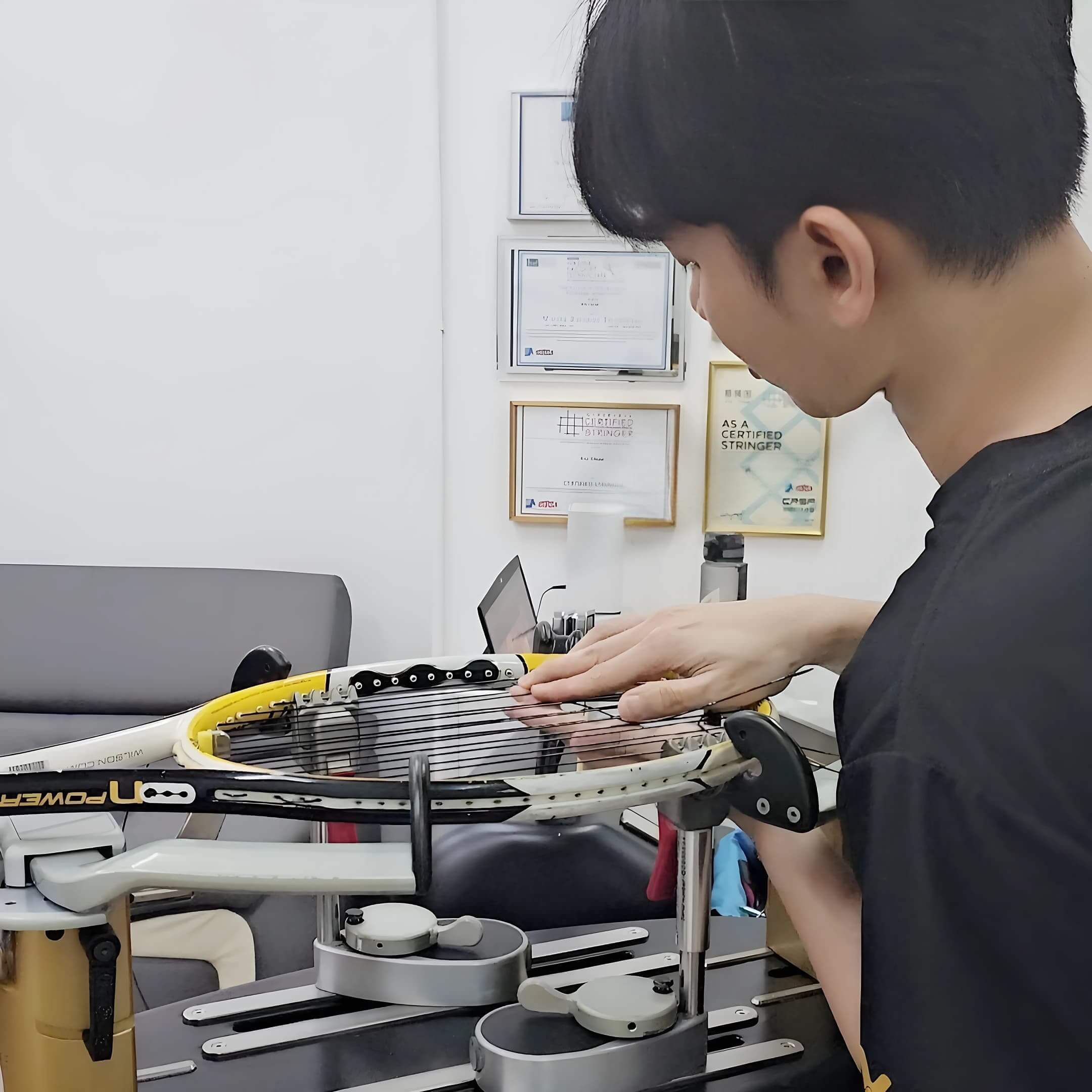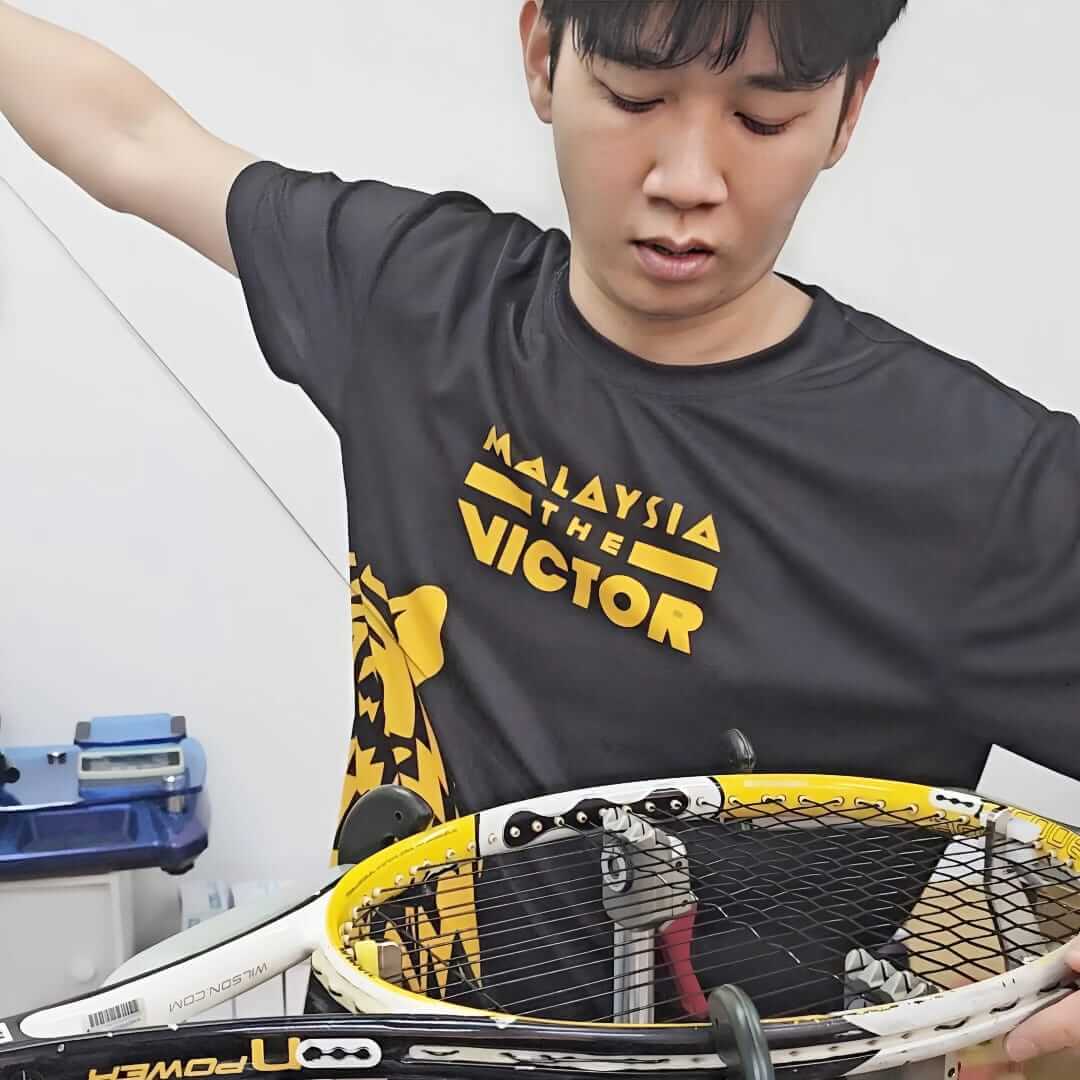In the world of tennis, the choice of string material can significantly impact a player’s performance, comfort, and overall experience on the court. As technology advances, new string materials emerge, offering players a wide array of options to suit their playing style and preferences. In this comprehensive guide, we’ll delve into two popular string materials: Kevlar & Aramid and Polyester. By the end of this article, you’ll have a thorough understanding of these materials and how they can influence your tennis game.
Introduction to Advanced Tennis String Materials
While traditional materials like natural gut and nylon have long been popular choices for tennis strings, advanced materials such as Kevlar & Aramid and Polyester have gained significant traction in recent years. These materials offer unique properties that cater to the evolving demands of modern tennis players, from recreational enthusiasts to professional athletes.
String Material Simulator
Recommended Material: Hybrid
Kevlar & Aramid: The Ultimate in Durability
Kevlar and Aramid are synthetic fibers known for their exceptional strength and durability. Originally developed for use in aerospace and military applications, these materials have found their way into the world of tennis strings, offering players unparalleled longevity and stability.
Characteristics of Kevlar & Aramid Strings:
- Durability: Kevlar and Aramid strings are arguably the most durable options available in the tennis string market. Their resistance to wear and tear makes them an excellent choice for players who frequently break strings or those looking for a long-lasting option.
- Stiffness: These strings are known for their high stiffness, which can provide excellent control and precision for players who can handle the reduced comfort level.
- Tension Maintenance: Due to their inherent stability, Kevlar and Aramid strings maintain their tension exceptionally well over time, ensuring consistent performance throughout their lifespan.
- Limited Elasticity: The high stiffness of these strings results in limited elasticity, which can reduce power and comfort compared to softer string materials.
- Hybrid Potential: Kevlar and Aramid strings are often used in hybrid setups, combining their durability with the comfort and playability of softer strings.
Understanding Kevlar & Aramid String Construction
Contrary to what some might expect, Kevlar and Aramid tennis strings often feel relatively soft to the touch. This is because they are typically constructed using a multifilament structure, where multiple thin fibers of Kevlar or Aramid are bundled together to form the string.
This construction method allows manufacturers to harness the incredible strength and durability of Kevlar and Aramid while mitigating some of their inherent stiffness. However, it’s important to note that despite this softer feel, these strings still provide a much firmer playing experience compared to materials like natural gut or synthetic gut.

Applications Beyond Tennis
The exceptional properties of Kevlar and Aramid extend far beyond the tennis court. These materials are used in various high-performance applications, including:
- Racquet Construction: Some tennis racquet frames incorporate Kevlar or Aramid fibers to enhance stability and reduce vibration.
- Bulletproof Vests: The high tensile strength and energy-absorbing properties of these fibers make them ideal for personal protective equipment.
- Aerospace Industry: Kevlar and Aramid are used in aircraft components due to their high strength-to-weight ratio.
Optimizing Kevlar & Aramid String Performance
While Kevlar and Aramid strings offer unmatched durability, their stiffness can lead to a harsh feel and potential discomfort for some players. To optimize performance and enhance playability, consider the following tips:
- Hybrid Stringing: Combine Kevlar or Aramid strings with a softer string material. For example, use Kevlar for the main (vertical) strings and a softer synthetic gut or multifilament for the cross (horizontal) strings.
- Tension Adjustment: When using Kevlar or Aramid strings, especially in a hybrid setup, consider reducing the tension by about 10% compared to your usual string tension. This can help improve comfort and overall feel without sacrificing too much control.
- String Gauge: Opt for a thinner gauge (higher number) of Kevlar or Aramid string to increase playability and reduce stiffness. However, keep in mind that thinner strings may sacrifice some durability.
- Regular Restringing: Despite their durability, it’s essential to restring regularly when using Kevlar or Aramid strings. Over time, these strings can lose their elasticity and become even stiffer, potentially increasing the risk of arm discomfort.
Polyester: The Spin Master
Polyester strings have revolutionized the tennis string market in recent years, gaining popularity among professional players and recreational enthusiasts alike. Known for their ability to enhance spin potential and control, polyester strings have become a go-to choice for many modern players.
Characteristics of Polyester Strings:
- Spin Enhancement: The low friction coefficient and snap-back properties of polyester strings allow players to generate more spin on their shots.
- Control: The stiffness of polyester strings provides excellent ball control, allowing players to hit with confidence and precision.
- Durability: While not as durable as Kevlar or Aramid, polyester strings offer good longevity, especially for players who generate heavy spin.
- Limited Power: The low elasticity of polyester strings means they don’t provide as much power as softer string materials.
- Tension Loss: Polyester strings are known to lose tension relatively quickly, which can affect performance over time.
The Rise of Polyester in Professional Tennis
The popularity of polyester strings in professional tennis can be attributed to their spin-enhancing properties and the evolution of playing styles. As the game has shifted towards more topspin-heavy groundstrokes, polyester strings have become an invaluable tool for players looking to maximize their spin potential.
Many top professional players use polyester strings or polyester-based hybrids in their racquets. This trend has trickled down to amateur and recreational levels, with players of all skill levels experimenting with polyester strings to improve their game.
Polyester String Technology Advancements
In recent years, string manufacturers have made significant advancements in polyester string technology:
- Shaped Strings: Many polyester strings now feature geometric cross-sections, such as pentagonal or octagonal shapes, designed to further enhance spin potential.
- Softer Formulations: Some manufacturers have developed softer polyester compounds that aim to provide the benefits of traditional polyester strings with improved comfort and feel.
- Texture and Coatings: Advanced manufacturing processes have allowed for the creation of textured polyester strings or those with special coatings to enhance grip on the ball and increase spin.
- Tension Stability: While tension loss remains a characteristic of polyester strings, some newer formulations offer improved tension maintenance, especially in the critical first 24 hours after stringing.
Optimizing Polyester String Performance
To get the most out of polyester strings, consider the following tips:
- Tension Selection: Many players find that stringing polyester at a lower tension than they would use for other materials can help improve comfort and power while maintaining control.
- Regular Restringing: Due to tension loss and performance degradation over time, it’s important to restring polyester more frequently than you might with other materials.
- Hybrid Setups: Combining polyester with a softer string material (e.g., polyester mains with synthetic gut crosses) can provide a balance of spin, control, and comfort.
- String Gauge: Experimenting with different string gauges can help you find the right balance between durability, spin potential, and feel.
| Property | Kevlar & Aramid | Polyester |
|---|---|---|
| Durability | Excellent | Good |
| Spin Potential | Moderate | Excellent |
| Control | Excellent | Very Good |
| Comfort | Poor | Moderate |
| Power | Low | Low to Moderate |
| Tension Maintenance | Excellent | Moderate |
| Ideal For | String breakers, players seeking maximum durability | Players seeking spin and control, modern playing styles |
| Common Uses | Hybrid setups, main strings | Full bed, hybrid setups |
Choosing Between Kevlar & Aramid and Polyester
Selecting the right string material depends on various factors, including your playing style, skill level, and personal preferences. Here are some guidelines to help you choose between Kevlar & Aramid and Polyester:
- Durability Seekers: If your primary concern is longevity and you’re willing to sacrifice some comfort, Kevlar & Aramid strings are the way to go. They’re ideal for players who frequently break strings or want to minimize restringing frequency.
- Spin Enthusiasts: If you rely heavily on topspin and want to maximize your spin potential, polyester strings are the better choice. They’re well-suited for players with modern, topspin-heavy games.
- Control Players: Both Kevlar & Aramid and polyester strings offer excellent control. Kevlar & Aramid might have a slight edge in this department due to their higher stiffness.
- Comfort Considerations: Neither material is known for comfort, but polyester strings, especially newer, softer formulations, tend to be more arm-friendly than Kevlar & Aramid.
- Budget: While both materials offer good durability, Kevlar & Aramid strings typically last longer, potentially offering better value in the long run.
Remember, the best way to find your ideal string is through experimentation. Consider trying both Kevlar & Aramid and polyester strings, as well as hybrid setups, to see which combination complements your game best.
String Life Calculator
The Impact of String Gauge
When choosing between Kevlar & Aramid and polyester strings, it’s also important to consider the string gauge. The gauge refers to the thickness of the string, which can affect its performance characteristics:
- Thicker Gauges (lower numbers): These tend to be more durable and provide more control but may offer less spin potential and feel.
- Thinner Gauges (higher numbers): These typically provide better spin potential and feel but may break more quickly and offer less control.
Both Kevlar & Aramid and polyester strings come in various gauges, allowing you to fine-tune your racquet setup further.
Maintenance and Care
To get the most out of your Kevlar & Aramid or polyester strings, proper maintenance is key:
- Storage: Keep your racquet in a cool, dry place when not in use. Extreme temperatures and humidity can affect string tension and longevity.
- Cleaning: Gently clean your strings after play to remove dirt and debris. A damp cloth is usually sufficient.
- Tension Check: Regularly check your string tension, especially with polyester strings. If you notice a significant drop in tension or performance, it might be time for a restring.
- Restringing Frequency: For polyester strings, consider restringing more frequently than you would with other materials. Kevlar & Aramid strings can last longer but should still be replaced before they become too stiff or lose their playability.
Understanding the characteristics of Kevlar & Aramid and polyester strings can help you make an informed decision about which material is best for your tennis game. Whether you prioritize durability, spin potential, or a balance of performance attributes, there’s a string out there that’s perfect for you.
Remember, the best tennis racquet stringing course can provide you with even more in-depth knowledge about string materials and their impact on play. Consider pursuing a tennis stringing certification to deepen your understanding and potentially open up new career opportunities in the world of tennis.
At Best Stringer Worldwide (BSW), we’re committed to helping players and stringers improve their knowledge and skills. By understanding the nuances of different string materials, you can optimize your equipment to elevate your game to the next level.
Test Your Knowledge
Now that you’ve learned about Kevlar & Aramid and polyester strings, let’s test your knowledge with a quick quiz:
Tennis String Materials Quiz
Whether you're a player looking to optimize your racquet or a stringer aiming to provide the best service to your clients, understanding tennis string materials is crucial. Continue exploring and experimenting with different strings to find the perfect combination for your game or your customers' needs.
Remember, the journey to becoming an expert in tennis racquet stringing is ongoing. Consider enrolling in a comprehensive tennis racquet stringing course or pursuing a tennis stringing certification to further enhance your skills and knowledge in this fascinating aspect of the sport.

About Best Stringer Worldwide
Best Stringer Worldwide is a comprehensive badminton and tennis stringing education program. We provide in-depth training on stringing techniques, racquet technology, and player-specific customization. Our curriculum is designed to help stringers understand and meet the needs of all badminton players, from casual enthusiasts to competitive athletes.
Read More